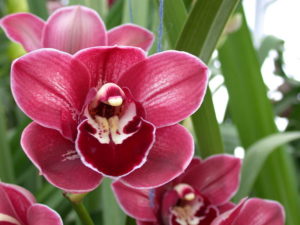Orchids are such popular plants and for good reason – they flower for long periods, make great gifts and come in a huge range of varieties and colours. But if you’ve ever wondered how to care for your orchids after they flower, Trevor Garard – Past President of the Orchid Club of South Australia – has some wise advice.
“Here are some valuable tips to make the most out of some of the more popularly grown orchids. If you are interested in learning more about any aspect of growing orchids, then we’d welcome new members to out club which provides a great avenue to learn more.”

Cymbidium – Boat Orchids – Once they’ve flowered, remove spent flowers stems at the base of the plant. While Cymbidiums like to be pot bound, they don’t like to have their bulbs on the edge of the pot, so you might need to replant them in a bigger pot – choose one with enough room for two years’ growth, or split the clump in half and replant in the original pot.
Remove any damaged roots in the process and replant in a mixture of one third of your chosen media (composted pine or coconut husk chunks are preferable), a two centimetre layer of Seamungus, and top the pot up with another layer of media. Position the bulbs towards the top of the pot with the roots firmly in the media, and water in well. Monitor water during the colder weather and increase watering as the weather warms up.
Did you know? Many orchid enthusiasts move their Cymbidiums to a warmer and sunnier spot on Anzac Day, returning it to a shelter on Melbourne Cup Day.
Phalaenopsis – Moth orchids are such a popular orchid as they flower for ages. Cut the old flower stem just above the second node from the bottom as soon as the last flower falls. If it doesn’t re-flower and the stem starts to dry up, remove at the base and new stems will re-shoot.
Moth orchids go into a phase or dormancy after flowering and can look quite unattractive. Reduce the amount of water you give them and repot them every second year – the smallest pot you have is the best. Combine a premium orchid bark with Seamungus pellets, spread the roots through the media and fill in. Water a day or so later and don’t forget to fertilise with Strike Back for Orchids once reshooting begins.
Australian Native Dendrobiums – These wonderful Australian native orchids are not overly fussy about being re-potted, so wait until the pot is almost ready to split! Repot in a slightly bigger pot in October and use orchid bark or coconut husk chunks with a layer of Seamungus pellets incorporated. If you want to divide your native Dendrobiums up, make sure you keep plenty of canes on each division. You can go easy on hand watering through winter – rain is generally plenty.
🌿 Ideally suited for establishing new plants and for use on natives, Seamungus can also be used as a plant tonic to revitalise all your plants throughout the year.
🌿 Strike Back for Orchids combines the best of both worlds – its organic base provides a full range of plant nutrients in a slow release form, whilst the carefully selected water-soluble nutrients have been added to maximise the performance of each application.
